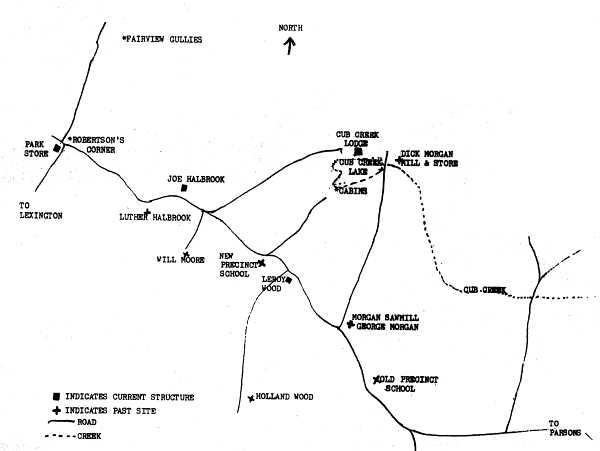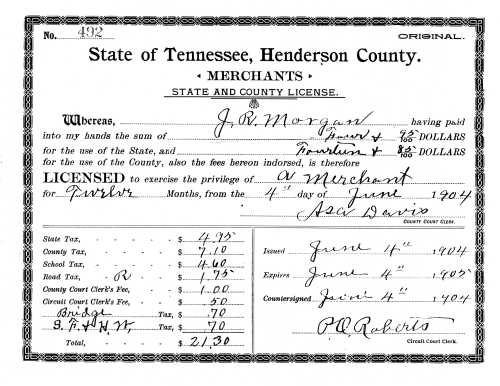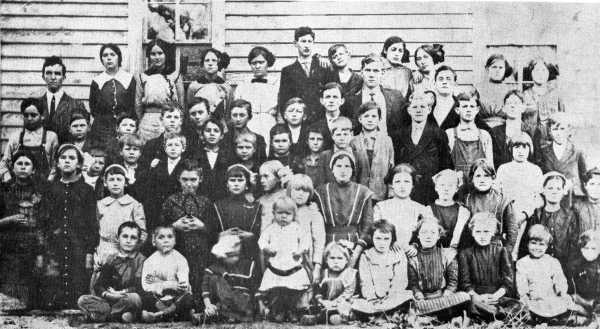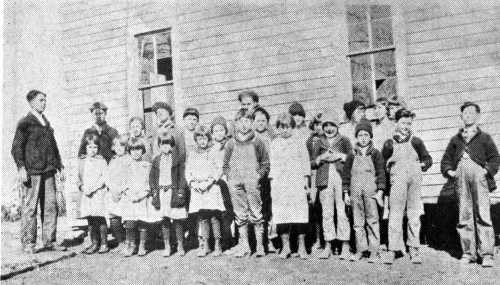yesterday's tennessee

Lexington Progress
November 25, 1992
Natchez Trace State Park has so long been a part of Henderson County that it is difficult to imagine what the area was like before 1935. Trail markers pointing the way to family cemeteries indicate names of families who once called this area home: Bradford, Todd, Cary, Webb, Myracle, Greener and Robertson.
Now almost 60 years later, only two of the original homes still stand. The Joe Halbrook house, built in the early 1900s is the oldest building on the park. The Leroy Wood house, built in 1921, is the last original settlement house. Even though both houses are listed on the Tennessee Register of Historic Places, no funds are available for restoration or even upkeep. [Note: The houses were burned March 24, 1994.]
By 1920, families making their living from farming were producing less each year and were moving out of the area. Sandy ridges farmed for several generations had so eroded that cultivation of crops was impossible on 50 percent of the cleared land. Photographs at the information center show houses and fences on the brink of gullies, some as much as 75 feet deep and 300 feet across, covering several acres. The most graphic example of what could have happened to the entire area if the soil erosion had been left unchecked is the Fairview Gullies.
The farmers were dirt poor and cash poor as well. They were especially hard hit by the Great Depression. According to statistics considered in the selection of land to be rehabilitated, the 350 families living in the 26-mile-long and nine-mile-wide project had average annual incomes of $175. No one was forced to move, but almost every family welcomed the opportunity to sell out to the government for an average price of $6.10 an acre. The families were described as being "very cooperative and deeply appreciative of any favor shown them." Approximately 40,000 acres were purchased for $250,000. Ironically, the cost exactly matched the number of check dams made of brush and logs built for erosion control. This seems like a high number of brush dams, but they were actually nothing but anchored logs with brush placed in front. (Horn Public Library has a copy of the project manual used in the construction.)

A map of Old Survey and Natchez Trace Park Cub Creek area. (Map by Robie Fiddler)
The village of Old Survey, near Cub Creek, had just about disappeared by 1920, but earlier, it had business establishments run by the Morgan family. As early as 1870, James J. Morgan (net worth $7,000) operated a gristmill later run by his son, J. R. "Dick" Morgan, also owner of a mercantile business. Morgan Post Office, located in the store, provided postal service. To the northwest, Albert Lovell operated a store and Fairview Post Office near the gullies. Area mail was picked up at Yuma where it was brought in by train.

Dick Morgan's merchant's license issued in 1904. (Courtesy of Jack Morgan)
Jack Morgan (son of Dick) of Wildersville is one of the few Morgans still in this area. His wife, Madge, remembers her father, Albert Hodge, telling of his riding a mule to Morgan's store to buy a wedding suit. On Valentine's Day, 1909, he and Hassie Todd went by buggy to the home of Justice-of-the-Peace Will Bolen where the ceremony was performed with them sitting in the buggy.
The site of the gristmill is adjacent to the Cub Creek Lake spillway; the preserved mill stones are now by the steps of Cub Creek Lodge. The Progress, in May 1937, reported that the county's first lake was becoming a reality with the recent heavy rains filling the 75-acre lake.
Near the gristmill, Morgan's brother, George A. Morgan ran a sawmill and. employed local men as well as men from other areas who boarded with him. As late as 1917, a hickory mill was still in operation.
A subscription school was in operation on land furnished by Holland Wood during the 1880g. In 1912, George Morgan deeded land to "the directors of Precinct School" for the establishment of a public school. The building served as the voting place for the Old 18th District Precinct, and it was to this small school house that men in the area between the ages of 18 and 45 went to register for the draft in the first world war.

Old Precinct School in 1913. The teacher was Harvey L. Bradfield. Front row
includes Fairy Wood, Vivian Davis,
Nettie Johnson, (2nd row) Vernie Lindsey, (3rd row, extreme left) Claude
Taylor, (4th row) Harvey Bradfield,
Effie Waugh, Cora Wood (girl in white with bow), Louie Autry, Gertie Morgan
(her father gave land for the
school). Other students in the picture include Clarence Reed (in suit and tie)
who taught at Precinct the
following year; Bill Reed, Jack Reed, Dalton Haney, John Haney, Covie Hodge,
Verlon Lindsey, Irby Davis,
Luther Davis, Jimmy Davis, Guy Moore and Obie Moore.
Larger image available (469K)
Mr. Eunice Wood taught school at Precinct during the winter of 1917-1918, the coldest winter on record locally with the Tennessee River frozen for days. All the ground was covered with snow from November to March, it was difficult to keep the schools open. Mr. Wood went daily to build a fire and wait for students who seldom came.
In 1922, the school was closed by the school board, who later agreed to pay for a teacher, if the parents would move the building westward to accommodate more students. Leroy Wood furnished the land and the building was dismantled, moved and reassembled with not one piece of lumber wasted.

The New Precinct School about 1924-25. Clyde Beeves was the teacher.
Students identified
include (front) Lucy Hendrix (third from left), Oron Wood (overalls), Alma
Moore, Ethridge
Hendrix (bandage), Edward Moore, Troy Stephens, Austin Stephens. The second row
includes
Bealer Johnson, Thomas Johnson, Lorene Moore, Tillman Stephens, Esmar Hodge and
Zora Taylor.
From 1916 through 1927, at least 11 teachers taught at "Old Precinct" and "New Precinct": Irby Lindsey, Cova Lewis, Ida Halters, Audie Duke, Obie Moore, Dennis Todd, Ernest Wilkins, Clyde Reeves, Neely Murren, Floyd Wood and Elmer Wallace. Earlier teachers included Clive Hendrix, Harvey Bradfield, Pauline Lindsey, M. E. Lindsey and Gladys Mitchell.
Mr. Murren taught at various schools in the area and usually took his school age children with him. Miss Robbie Murren recalls her father, not wanting to seem partial to his own children, was strict on her and sister Annie Belle, and when. he said "' Froggie,' we hopped." Her favorite classmate at Precinct in 1925 was Romney Bolen, "a really cute little boy who was knee high to a duck."
One day in 1926, the students were "at books" when they heard a loud noise outside. In spite of Mr. Floyd Wood's warning that they would lose their recess, they continued to look out the window to watch the large machine with a large blade coming down the road. This was the first time that a county road maintainer had been used for road repair, so it was a strange sight, according to Mrs. Lucy Petty.
When the school closed in 1929, Leroy Wood turned it into a dwelling for his son, Oron. Later, park employees lived in the house before it was demolished in the early 1940s.
Project Manager W.C. Kelley oversaw the actual construction of Natchez Trace Forest, one of three park projects in the state developed in President Franklin Roosevelt's New Deal. Construction work was begun in November 1935 and, by. July 1936, he reported much progress with 26 miles of improved roads and an average of 882 men carried on the payroll averaging about $20 monthly. A sawmill had milled 400,000 feet of lumber. Other than dressed lumber for flooring, window and door frames, all materials for construction were furnished locally. Even the ax handles were made on the park. A brick kiln had been installed and 300,000 bricks made. Concrete had been poured for the dam and Cub, Brown and Maple Creek Lakes were under construction. Two million seedlings had been set out over 6,000 acres and kudzu vines from Mississippi had taken root in the gullies. This progress, impressive figures for six months of work, was in keeping with the motto of the Resettlement Administration: Conserve our resources and save a peat nation.
|
Dusty roads in the summer and muddy roads in the winter made |
Travel was often difficult on roads |
Sidebar: "Pre-Park" Settler Families
top · home · yesterday's · families · schools · links · what's new · memorial · about
This site was created by David Donahue and Brenda Kirk Fiddler.
This site is currently maintained by Jerry L. Butler
Copyright © 2004 - 2010, All rights reserved